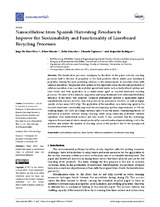Nanocellulose from Spanish Harvesting Residues to Improve the Sustainability and Functionality of Linerboard Recycling Processes
Autor
De Haro-Niza, Jorge
Rincón, E.
Gónzalez, Zoido
Espinosa, E.
Rodríguez, Alejando
Editor
MDPIFecha
2022Materia
Horticultural residuesVine shoots
Cellulose nanofibers
Linerboard recyclin
METS:
Mostrar el registro METSPREMIS:
Mostrar el registro PREMISMetadatos
Mostrar el registro completo del ítemResumen
The hornification processes undergone by the fibers in the paper industry recycling processes lead to the loss of properties of the final products, which exhibit poor mechanical properties. Among the most promising solutions is the reinforcement of secondary fibers with cellulose nanofibers. The present work addresses two important issues: the efficient production of cellulose nanofibers from scarcely exploited agricultural wastes such as horticultural residues and vine shoots, and their application as a reinforcement agent in recycled linerboard recycling processes. The effect of the chemical composition and the pretreatment used on the nanofibrillation efficiency of the fibers was analyzed. Chemical pretreatment allowed a significantly higher nanofibrillated fraction (45–63%) than that produced by mechanical (18–38%), as well as higher specific surface areas (>430 m2/g). The application of the nanofibers as a reinforcing agent in the recycled linerboard considerably improved the mechanical properties (improvements of 15% for breaking length, 220–240% for Young’s modulus and 27% for tear index), counteracting the loss of mechanical properties suffered during recycling when using chemically pretreated cellulose nanofibers from horticultural residues and vine shoots. It was concluded that this technology surpasses the mechanical reinforcement produced by conventional mechanical refining used in the industry and extends the number of recycling cycles of the products due to the non-physical modification of the fibers.

